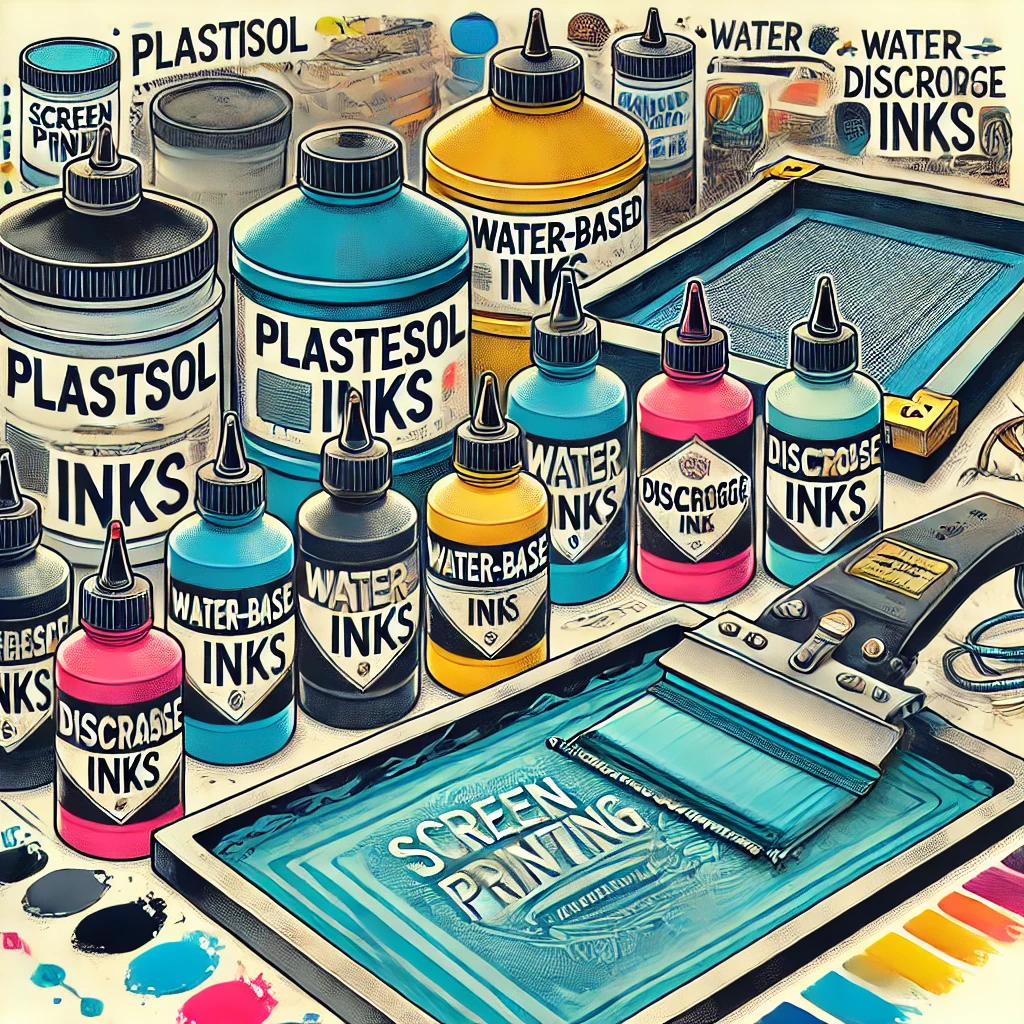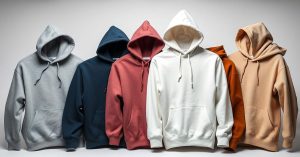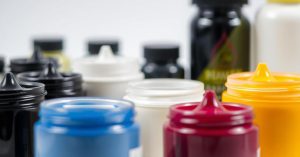Ever wondered why some prints crack and fade, while others stay bright for years? It’s often the ink choice that makes the difference. When making custom clothes or items, picking the right ink is key to getting top-notch results.
Screen printing has many ink types, each for different materials and uses. Whether it’s t-shirts or posters, the right ink ensures the best look and lasts longer.
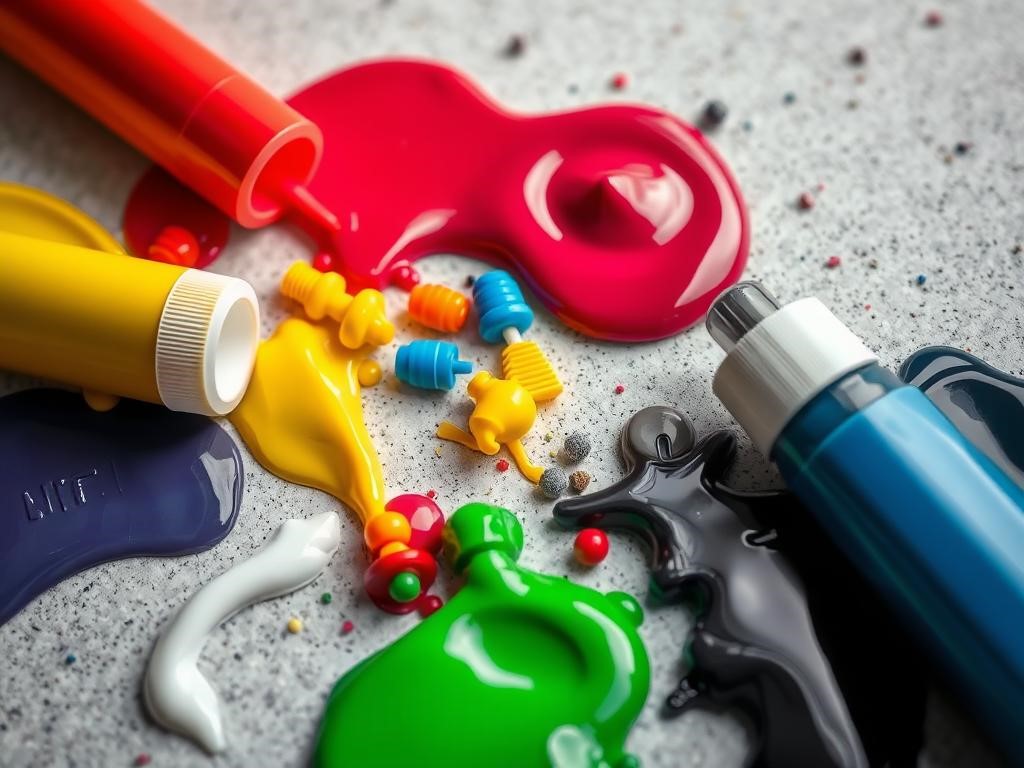
Printing tech has changed a lot over the years. Today, you can use plastisol, eco-friendly water-based, or special inks for tough surfaces. This variety is great for creativity but can be overwhelming for beginners.
Knowing about different inks helps artists get the best colors, textures, and durability. Whether you’re just starting or are a pro, choosing the right ink for your project saves time and effort.
Key Takeaways
- The type of ink significantly impacts the quality, durability, and feel of screen printed designs
- Different substrates (fabrics, paper, plastics) require specific ink formulations for optimal results
- Water-based inks offer eco-friendly alternatives to traditional plastisol options
- Specialty inks exist for challenging applications like stretchy fabrics and metallic finishes
- Proper ink selection affects production efficiency, cure times, and overall cost
- Understanding ink properties helps prevent common issues like cracking, fading, and wash-out
Table of Contents
Understanding Different Types of Screen Printing Ink
Screen printing offers many ink options, each with its own benefits. Choosing the right ink can make a big difference in your prints. Let’s look at the main types of screen printing inks and what makes them special.
Plastisol Ink: The Industry Standard
Plastisol ink is the most widely used ink in screen printing. It’s made from PVC and is oil-based. This ink sits on top of the fabric, giving it a raised texture and bright colors.
One great thing about plastisol ink is that it lasts forever if stored right. It won’t dry out in the screen, which is good for beginners and pros alike. It’s also great for printing on dark fabrics without needing an underbase.
But plastisol has some downsides. It needs to be cured at 300-330°F to set properly. The prints can feel heavy, which some people don’t like.

Water-Based Ink: The Eco-Friendly Alternative
Water-based screen printing inks are becoming more popular for being eco-friendly. They’re made with pigments in water, not plastic. This makes them softer on fabrics.
Water-based ink goes into the fabric, not just on it. This makes the prints feel like part of the fabric, not just added on. Many high-end clothing brands use this ink for its comfort and breathability.
Working with water-based inks can be tricky. They dry fast in the screen, so you need to be careful. Getting good colors on dark fabrics can be hard, sometimes needing extra passes or an underbase. But the eco benefits and feel make it worth learning.
Discharge Ink: For Vibrant Prints on Dark Fabrics
Discharge ink is special for printing on dark clothes without the heavy plastisol feel. It’s a water-based ink that removes the existing dye and adds new color.
This ink makes the print part of the fabric, not just on it. For example, on black cotton shirts, it removes the black dye and adds your color. This creates a soft, vibrant print.
Discharge ink works best on 100% cotton. It doesn’t work well on synthetic fibers or blends. Also, it has a strong smell during printing and curing, so you need good air in your workspace.
Other Ink Types: Acrylic, Solvent, and Oil-Based
There are also other specialized inks for screen printing. Acrylic inks are a mix between plastisol and water-based, air-drying well. They’re good for polyester because they don’t need heat.
Solvent-based inks are for printing on non-porous surfaces like plastic and glass. They’re used for industrial printing, not fabrics. They need safety gear and good air because of their strong chemicals.
Oil-based inks are used for fine art and special prints. They give great detail and a unique look. But they take longer to dry and need special care.
|
Ink Type |
Best For |
Advantages |
Limitations |
|
Plastisol |
All-purpose printing, dark fabrics |
Vibrant colors, doesn’t dry in screen, excellent opacity |
Heavier hand feel, requires heat curing, less eco-friendly |
|
Water-Based |
Soft-hand prints, light fabrics |
Eco-friendly, soft feel, breathable |
Dries quickly in screen, less opaque on dark fabrics |
|
Discharge |
Dark cotton garments |
Extremely soft hand, vibrant on dark fabrics |
Works only on cotton, produces odor, requires activator |
|
Acrylic |
Polyester, heat-sensitive fabrics |
Can air dry, good for polyester |
Less durable than plastisol, moderate opacity |
Knowing about these different inks helps you choose the best one for your project. Each ink has its own strengths that can improve your screen printing when matched right.
Best Screen Printing Ink for Different Fabrics
Choosing the right screen printing ink for your fabric is key. It ensures your design sticks well, looks bright, and lasts through washing. Knowing how ink and fabric work together helps avoid common mistakes and gets you professional results every time.
Cotton and Natural Fibers
Cotton and other natural fibers like hemp, linen, and bamboo are great for screen printing. Their absorbent nature and texture make them perfect for ink adhesion. Most ink types work well on these materials with little prep needed.
Plastisol ink is top-notch for cotton, offering great color and durability. Its thick consistency sits on the fabric, making prints vibrant and lasting. For reliable prints on cotton, plastisol is the best choice.
Water-based inks are great on natural fibers, giving a soft, breathable finish. They blend into the fabric, making prints feel like part of the garment. This makes water-based inks popular for fashion and quality apparel.
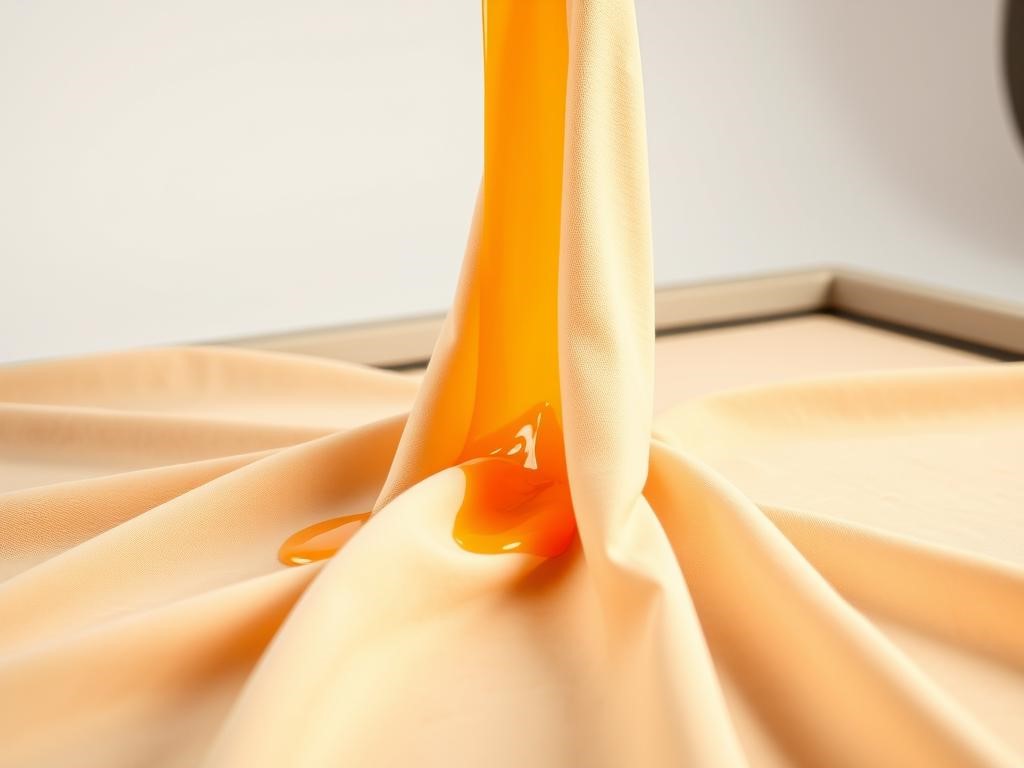
Discharge inks work by reacting with cotton dyes, creating soft prints on dark cotton. They’re perfect for dark garments without the heavy feel of plastisol. But, they work best on 100% cotton and might not work well on blends.
Polyester and Synthetic Materials
Synthetic fabrics like polyester are tricky for screen printers. Polyester’s smooth surface makes ink adhesion hard. Also, it can get damaged by heat, so temperature control is crucial.
The biggest challenge with polyester is dye migration. This happens when the garment’s dye bleeds into the ink during curing, causing color changes. Red polyester is often a problem, turning white prints pink.
Low-bleed inks help fight dye migration in polyester. These special plastisol inks have agents that block dye migration. For best results on polyester, use low-bleed white ink as an underbase or standalone.
When printing on synthetics, controlling temperature is key. Polyester starts to scorch at 320°F, but inks need higher temperatures to cure. Special inks that cure at 270-300°F reduce fabric damage while ensuring ink adhesion.
Blended Fabrics and Special Textiles
Blended fabrics mix different fibers, requiring careful consideration. Poly-cotton blends offer a balance between natural and synthetic challenges.
Standard plastisol inks work on poly-cotton, but dye migration is still a risk. Using a low-bleed white ink underbase helps prevent this while keeping print quality. The more polyester in the blend, the more important this is.
Performance fabrics for athletic wear have spandex for stretch. Special inks are needed to keep prints flexible after curing. Stretch inks have additives for flexibility without cracking or peeling.
Specialty textiles like fleece and tri-blends each have their own challenges. Fleece needs inks that fill its textured surface. Tri-blends require low-bleed properties and additives for adhesion to rayon.
Light vs. Dark Garments: Ink Considerations
The color of your garment affects your ink choice and technique. Light-colored fabrics are easy, as most inks show well without prep. On white or light-colored garments, thinner ink deposits work well for accurate colors.
Dark garments need special approaches. Standard inks can’t cover dark backgrounds well, making colors dull. To get vibrant prints on dark fabrics, you can use high-opacity inks or an underbase technique.
High-opacity inks are made to cover dark backgrounds in fewer passes. They might make prints feel heavier. White high-opacity ink is great for black garments.
The underbase technique involves a white ink layer that’s partially cured before adding final colors. This creates a clean canvas for the next layers, ensuring brighter colors on dark fabrics. Though more work, it often gives better results.
|
Fabric Type |
Recommended Ink |
Special Considerations |
Best Applications |
|
100% Cotton |
Plastisol, Water-based, Discharge |
Excellent ink absorption, minimal dye migration |
Retail apparel, band merchandise, fashion prints |
|
100% Polyester |
Low-bleed Plastisol |
Dye migration, heat sensitivity (max 320°F) |
Sports jerseys, performance wear, safety garments |
|
Poly-Cotton Blends |
Low-bleed Plastisol, Modified Water-based |
Partial dye migration, moderate heat sensitivity |
T-shirts, hoodies, workwear, promotional items |
|
Nylon/Synthetic Blends |
Nylon-specific Plastisol with Catalyst |
Poor ink adhesion, requires adhesion promoter |
Jackets, bags, umbrellas, technical apparel |
|
Performance/Stretch Fabrics |
Stretch Plastisol, Silicone-based |
Needs flexibility, heat sensitivity, dye migration |
Athletic wear, compression garments, swimwear |
Special Effects and Specialty Screen Printing Inks
The world of specialty screen printing inks brings new creative possibilities. Artists can add dimension, shine, and interactive elements to their work. These special effects inks turn ordinary clothes into eye-catching pieces. Let’s dive into the exciting options for screen printers to enhance their craft.
Metallic and Glitter Inks
Metallic ink adds sparkle to designs. It’s made with tiny metallic flakes in a plastisol base. This creates a shimmering effect that catches the light.
These inks need special handling because of their thickness and metallic particles. Printers use lower mesh counts (86-110) to let the flakes pass through without clogging. The result is a premium look that customers are willing to pay for.
Glitter inks take the shimmer effect further with larger reflective particles. They come in various colors and sizes for customization. But, both metallic and glitter inks have limitations for fine detail work due to the particles’ size.
Glow-in-the-Dark and Reflective Inks
Glow in the dark ink is perfect for prints that shine in the dark. It contains phosphorescent pigments that absorb and then emit light slowly. This creates an eerie glow ideal for Halloween, concert merchandise, or safety designs.
For the best glow, use glow-in-the-dark ink on light-colored fabrics or over a white base on darker clothes. The ink’s thickness affects the glow’s intensity and duration, so multiple passes may be needed.
Reflective inks work differently, reflecting light back to its source. They’re great for safety apparel, running gear, or any visibility needs. Show the effect with a flashlight to impress customers.
Puff and Texture Inks
Puff ink adds dimension to prints, creating a soft, raised effect. It expands when heated, mimicking embroidery without the cost. This specialty ink engages more than just sight.
The curing process is key for puff printing. When heated, the ink expands several times its original thickness. The expansion depends on the ink’s thickness and the curing temperature.
High-density inks create dramatic 3D effects by building up in layers. Unlike puff inks, they don’t expand during curing but keep their thickness. They’re perfect for logos that stand out.
Suede and Soft-Hand Additives
Suede additives turn standard plastisol inks into velvety, soft textures. This creates a premium feel, popular for fashion-forward apparel.
Soft-hand additives solve the plastic-like feel of standard plastisol prints. They mix with regular inks to create a softer, more flexible print. This makes the garment more comfortable and flexible.
When using these additives, they reduce the ink’s opacity. You might need more passes or a white underbase on darker fabrics. Balancing softness and opacity is crucial in planning your print jobs.
Specialty inks require expertise and often cost more than standard ones. But, they create unique effects that allow printers to charge more. Mastering these special effects can attract clients seeking something unique.
Factors to Consider When Choosing the Best Screen Printing Ink
Choosing the right screen printing ink is more than just picking between plastisol and water-based. You need to think about how each ink works in different situations. The best ink for one job might not work for another. So, it’s important to consider these factors carefully to save time, money, and avoid frustration.
Print Durability and Washability
When people order custom printed clothes, they want the designs to last. Durability and washability are key when picking screen printing ink. Plastisol ink is known for being very durable, keeping colors bright even after many washes.
But, plastisol ink has its downsides. It doesn’t soak into the fabric, which means it can crack when exposed to heat or stretched. This is a big problem for clothes that get a lot of wear and tear.
Water-based inks, on the other hand, fade faster with washing because they soak into the fabric. But, if you cure them properly, they can last almost as long as plastisol. Adding a special ingredient called a catalyst can make water-based inks even more durable.
Curing Requirements and Equipment
Each ink type needs a specific way to cure to last. Curing requirements affect how you work and what equipment you need. Plastisol ink needs to be cured at about 320°F (160°C) to fully set.
Water-based inks cure by drying and need a bit lower heat, around 300°F (149°C). They might need to stay in the dryer longer. Some water-based inks can air-dry, but heat curing makes them last longer.
What equipment you have is also important. If you have a basic heat press or flash dryer, plastisol might be easier to work with. But, if you have a conveyor dryer, you can use either ink type. Beginners might find plastisol easier because it has a wider curing range.
Ink Opacity and Coverage
Opacity is how well an ink covers the fabric, which is crucial for dark clothes. Plastisol ink is great at opacity, making it perfect for dark fabrics. Its thick texture lets it stay on top of the fabric, hiding the garment’s color.
Water-based inks used to struggle with opacity on dark fabrics. But, new high-solid water-based inks have more pigment and binders, improving coverage.
To get the best opacity, use an underbase—a white layer first. Double-hitting (printing the same color twice) can also help, but it needs precise registration. The right ink depends on the fabric color and design details.
Environmental and Safety Concerns
The impact of screen printing on the environment is becoming more important. Eco-friendly options are becoming more popular. Water-based inks are seen as more eco-friendly than plastisol, but it’s not that simple.
Water-based inks use water instead of PVC plastics, but they still have acrylic polymers and binders. They release solvents during curing, leaving pigments on the garment. But, they have fewer harmful chemicals and produce less waste than plastisol.
Safety also includes health in the workplace. Plastisol inks contain phthalates unless they are phthalate-free. These chemicals have health concerns, leading to phthalate-free options. Water-based inks need better ventilation during curing because they release more fumes.
Proper disposal is crucial for both ink types. Don’t wash plastisol down drains, and filter water-based ink waste before throwing it away. Many suppliers offer ink recycling programs to help the environment.
When picking the best ink, think about your needs, equipment, the clothes you print on, and your environmental goals. The right choice balances these factors for the best results.
Making the Right Choice for Your Screen Printing Projects
Choosing the right ink for your screen printing project is easier than you think. Most inks from well-known brands work well if used right. Instead of looking for the “one best ink,” find the one that fits your needs.
First, think about what you’re printing on. Cotton clothes might do well with water-based or discharge inks. Polyester, on the other hand, needs special inks. Dark fabrics need inks that cover well, while light fabrics give you more options.
For newbies, plastisol inks are a great choice. They’re easy to work with, versatile, and don’t dry in the screen. As you get better, try water-based inks for softer prints or special inks for cool effects.
Think about more than just print quality. What screen printing supplies are easy to find near you? Do you have ink makers who can help? What kind of curing equipment do you have?
The print world has many choices, but your ink should match your budget, tools, and what your customers want. Test different inks on your materials before buying a lot.
Choosing the best ink is about finding what works for you. The perfect ink is the one that makes your screen printing projects look great.
Why the Best Screen Printing Ink Matters for Your Brand
At Design Brand Print, we know that choosing the best screen printing ink isn’t just a technical decision. It’s the foundation of every high-quality screen printing services we deliver. From vibrant plastisol prints to breathable water-based designs and specialty effects like puff or metallic finishes, we tailor our ink choices to your fabric, purpose, and vision. This attention to detail ensures your garments don’t just look great when they’re new. They stay sharp, comfortable, and professional after every wash.
Whether you’re creating custom apparel for your brand, uniforms for your team, or limited-edition merchandise, our screen printing process is built around durability, color accuracy, and finish quality. We work with top-tier inks and industry-standard curing methods to ensure every print lasts and feels just right. Our team understands how ink interacts with different materials, from cotton to poly blends and performance fabrics, so we can confidently recommend and apply the optimal ink solution for your needs.
When you print with us, you’re not just getting ink on fabric. You’re getting a strategic blend of the right ink, equipment, and expertise that brings your designs to life with clarity, texture, and staying power.
Ready to bring your vision to life with prints that stand out and hold up? Contact Design Brand Print today and let’s create something bold, brilliant, and built to last.

